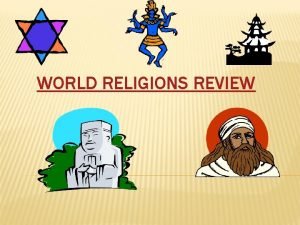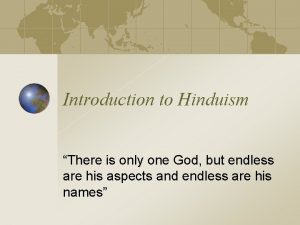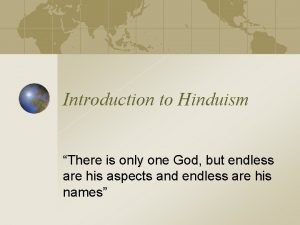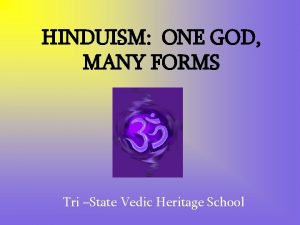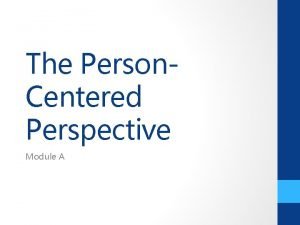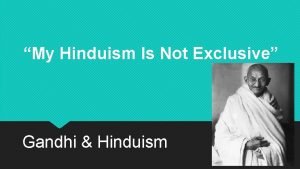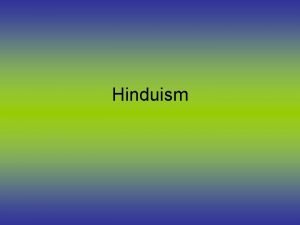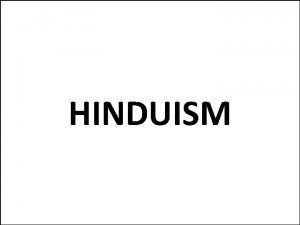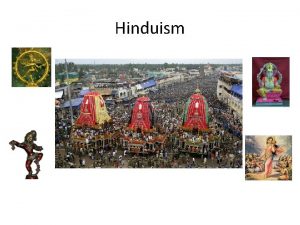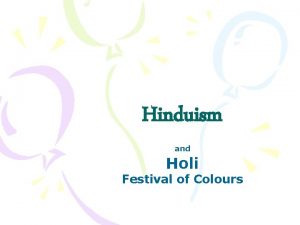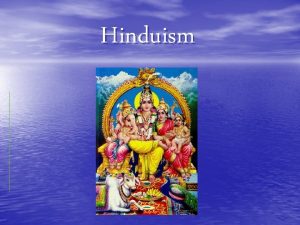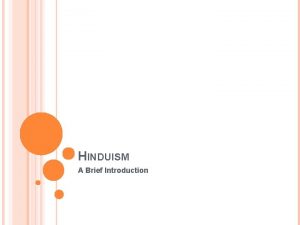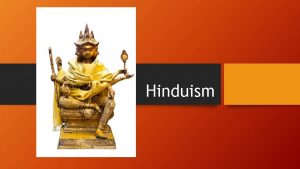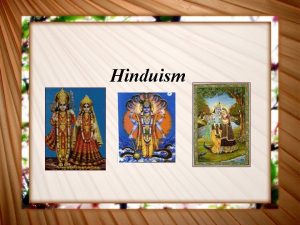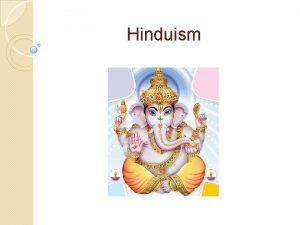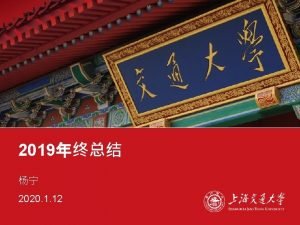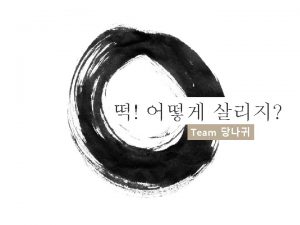Hinduism page 14 Hinduism is one of the















































- Slides: 47

Hinduism (page 14) • Hinduism is one of the oldest and most complex religions in the world. Unlike most religions, Hinduism has no single founder. It developed and changed over 3, 500 years, growing out of the diverse people who settled in India. (Cultural Diffusion? ? ? )

Hinduism • Hindus believe in one unifying spirit, _Brahman_______. Brahman is too complex for humans to understand, therefore, Hindus worship gods that give a more concrete form of Brahman.

Hindu GODS • How does a Hindu become closer to the Brahman? • Follow the three main Hindu Gods. » BRAHMA- the Creator » VISHNU- the Preserver » SHIVA- the destroyer Reincarnation- rebirth of the soul in a new body

Reincarnation: • Achieving union with Brahman is the ultimate goal for Hindus. This is called ____Moksha (Enlightenment)_______. • Most people cannot achieve this union in one lifetime. The concept of _____Reincarnation__________, the rebirth of the soul in a new body, allows people to continue their journey toward union with Brahman.

People get closer to Brahman by obeying the laws of Karma/Dharma • Karma- all the religious actions of a person’s life that affect’s his/her existence in the next life. • Dharma- religious duties that are expected of an individual (age, class, gender).

Hindu caste system (page 15)

Hinduism • List 8 facts on the back of your packet.

Buddhism (page 16)

Preview • Write down 4 things that make you happy. • Place responses on page 16.

Buddhism • The Buddhism has a different view on happiness. • The Buddhist approach to happiness is to give up desire. • Buddhism argues desire of material goods and status cause suffering. • When one gives up desire, one achieves happiness. • Buddhist call this Nirvana.

Buddhism • Complete page 18 in packet.

Buddhism (pg 18 in packet) 1) Who is the founder of Buddhism? • Siddhartha Gautama 2) He was a prince in Nepal, a country north of India. Why did he leave home? • Find the meaning of life or what is the cause of suffering

Buddhism (pg 18 in packet) 3) What did Siddhartha suddenly realize after much meditation? What was he known as? • Reason for human suffering • The Buddha (Enlightened One)

Buddhism (pg 18 in packet) 4) Write down the Four Noble Truths. 1. All humans suffer and feel pain 2. Suffering is caused by Desire, by wanting what one can’t have 3. Suffering ends when one puts aside Desire 4. Desire may be overcome by following certain rules

Buddhism (pg 18 in packet) 5) What do the rules of the Eight Fold Path have to do with? • All eight rules have to do with being gentle, unselfish, and mindful of others.

Buddhism (pg 18 in packet) 6). Name and describe the ultimate goal of the “Eightfold Path”. • NIRVANA is a state of mind that is blessed with understanding, peace, and freedom.

Buddhism (pg 18 in packet) 7) What is the sacred text of Buddhism? • Tripitaka

Buddhism (pg 18 in packet) 8) What beliefs of Hinduism do Buddhists reject? • Caste System

Buddhism (pg 18 in packet) 9) Name and explain the concept Buddhists do keep from Hinduism. • Reincarnation

Buddhism (pg 18 in packet) 10) To what do Buddhist monks and nuns devote their lives? • To poverty, meditation, and study. To learn humility, monks must beg for food and money.

Buddhism • List 8 facts on the back of your packet.

Venn Diagram • Page 19 in packet. • x 5 examples per Hinduism, Buddhism, & similarities.

Shintoism (page 20 in packet)

Shintoism Video • https: //www. youtube. com/watch? v=Lo. Qqxd. A b. RS 0

Shintoism Shinto is the ancient religion of Japan—at least 1500 years old. Shinto evolved from a mixture of tribal religions. “Shinto” means way of the Gods. Shinto emphasizes an appreciation for the beauties in nature. Today, many Japanese people combine Shinto rituals with other religions, especially Buddhism. Shinto and Buddhism both became official religions of Japan in about 700 CE.

Shinto Worship According to Shinto, nature is full of spirits, called Kami. People worship Kami and ask them for favors at shrines and at home. Shrines can be large or small, but all have one or more gates. These gates represent the line between the everyday world and the spiritual world. Shrines are typically found near places of impressive natural beauty (lakes, mountains, etc). People bow as the pass through the gates of the shrines. Shinto priests bang drums close to the shrine of the Kami. This alerts the Kami to the presence of worshipers.

Teachings and Beliefs Shinto teaches that there is a sacredness of the whole universe and that humans can be in tune with this sacredness. Every mountain, river, plant, animal, and all the diverse phenomena of heaven and earth have spirits, or kami, which inhabit them. Reverence is paid to the ancestors through the practice of ancestor worship

Food for thought… Many Japanese people practice both Buddhism and Shinto. How is it possible to be both a Buddhist and Shintoist? What does this tell you about Japanese thinking?

ANIMISM

Animism is the oldest known type of belief system in the world. It is still practiced in a variety of forms in many traditional societies. Animists practice nature worship. They believe that everything in the universe has a spirit. This is exemplified by the practices of the Plains Indians in North America who would praise the spirit of the buffalo that they killed for giving its life to them so that they might survive. Animists also believed that ancestors watch over the living from the spirit world. This belief resulted in ancestor worship as a means of communicating with and showing respect to ancestors.

Multiple Choice Practice 1. Animism is a belief that a. all animals are gods b. every living and nonliving thing in nature has a spirit c. animals should not be killed for food 2. Animism was generally a belief system of a. the Hindus b. the Ninjas c. early societies 3. Shinto means a. the way of the gods b. the samurai afterlife c. Asian spirits

4. Shintoism is the native religion of a. China b. Korea c. Japan 5. Shinto is characterized by the worship of a. atman b. kami c. haiku 6. The philosophy of Shintoism is based on a. respect for national royalty b. reverence for small animals c. respect for the powerful forces of nature 7. Shintoism also involves the worship of a. ancestors b. the Virgin Mary c. dynasties 8. Shintoism is practiced alongside the religion a. Judaism b. Buddhism c. Islam

Words of Wisdom • In groups of 2 -4 create a phrase or statement encouraging 1 of the following behaviors: • Be a good person, work hard, help the greater good, or never give up. • Write your statement down on a sheet of computer paper. • Transfer to the big brown paper, & on the back or on a separate sheet of paper describe how your phrase/statement is encouraging good behavior.

CONFUCIANISM (page 24)

CONFUCIANISM • Philosophy that originated in China (550 BCE). • Goal of the founder Confucius was to promote social order & good behavior in society. • Confucius used phrases or sayings as a method to motivate people to follow his ideas.

Top 2 Confucius Quotes!! • “Do not do on to others as you do not want done to you. ” • “Respect your parents. ”

CONFUCIANISM • https: //www. youtube. com/watch? v=Gb. PKxn OMIu. U

Harmony & Order Confucius (Kung Fu-tz 551 BCE) was China’s most famous philosopher. Confucianism, the way of life based on the ideas and teachings of Confucius, has probably influenced more people than any other set of rules concerning human behavior. He taught that if each man knew the proper conduct expected of him, then he would follow it. He believed each man must work to keep the rules of harmony and order. The family was to teach the rules of harmony and order. His ideas are collected in a book called the Analects. Confucius traveled throughout China lecturing the people on the wisdom of his ideas. To this day, his rituals are still practiced and his attributes accepted by many especially in China, Korea and Japan.

Four Classes… Scholars & Rulers: provide harmony and order to society Peasants (Farmers): produced the food that society needs Craftsmen & Artisans: produced products society needs Merchants: did not produce anything, but acted as middlemen **Confucius did not rank soldiers because they were breaking the rules of harmony and order.

Five Human Relationships… 1. Ruler to Subject Ruler must set proper example, if not, could overthrow! 2. Father to Son Father must be worthy model for children. Must guide behavior & develop character. 3. Husband Wife Husband was head of family & protected reputation. 4. Elder Brother to Younger Brother Older son is to model his behavior for his younger brothers. Younger brothers were expected to accept the place of the older brother without complaint. 5. Friend to Friend The only equal relationship. The Confucian Golden Rule applies: “Do not do on to others as you do not want done to you. ”

Family!!! Confucius taught that FAMILY, not the individual, was at the basic unit of Chinese life. The family included all relatives. The oldest person was the honored and obeyed family head. The family assumed responsibility for the livelihood and good conduct of its members. Marriage was not intended for individual happiness, but to perpetuate the family. Individuals had to live by a code of ethics that guided all behavior: 1. Careful observance of ancient traditions, 2. Reverence for learning, 3. Cherishing of honesty, 4. Devotion to parents, family, and friends, 5. Obedience to the “golden rule”. For more than 2000 years, Confucianism dominated Chinese daily life and politics. Confucian writings served as official school textbooks. Confucianism stabilized society but often halted progress. Intense family loyalty hampered the development of Chinese nationalism.

FILIAL PIETY Respect shown by children for their parents & elders!!!!

Taoism (page 26 in packet)

TAOISM • https: //www. youtube. com/watch? v=d. Fb 7 Hxv a 5 rg

Legalism • All people are equal before the law. • If you break the rules you are punished (harsh punishments are used). • If you follow the rules you are rewarded.

Legalism • http: //www. historyshistories. com/china-three -philosophies. html

Debate (place response @ bottom of page 26) • Confucianism, Taoism, & Legalism. • Which philosophy do you agree with the most & why?
 Religion title page
Religion title page Apa.format title page
Apa.format title page One god one empire one religion
One god one empire one religion One one little dog run
One one little dog run One king one law one faith
One king one law one faith One empire one god one emperor
One empire one god one emperor One ford plan
One ford plan See one do one teach one
See one do one teach one One price policy
One price policy Structure of twelfth night
Structure of twelfth night See one do one teach one
See one do one teach one Asean tourism strategic plan
Asean tourism strategic plan Asean one vision one identity one community
Asean one vision one identity one community One god hinduism
One god hinduism Is there only one god in hinduism
Is there only one god in hinduism Hinduism one god many forms
Hinduism one god many forms 2-pager examples
2-pager examples One page profile
One page profile Xoserve-detail-page-one (xoserveservices.com)
Xoserve-detail-page-one (xoserveservices.com) Concept document game design
Concept document game design One page response
One page response One page apresentação pessoal
One page apresentação pessoal Hát kết hợp bộ gõ cơ thể
Hát kết hợp bộ gõ cơ thể Ng-html
Ng-html Bổ thể
Bổ thể Tỉ lệ cơ thể trẻ em
Tỉ lệ cơ thể trẻ em Voi kéo gỗ như thế nào
Voi kéo gỗ như thế nào Glasgow thang điểm
Glasgow thang điểm Chúa yêu trần thế
Chúa yêu trần thế Môn thể thao bắt đầu bằng từ đua
Môn thể thao bắt đầu bằng từ đua Thế nào là hệ số cao nhất
Thế nào là hệ số cao nhất Các châu lục và đại dương trên thế giới
Các châu lục và đại dương trên thế giới Công thức tính thế năng
Công thức tính thế năng Trời xanh đây là của chúng ta thể thơ
Trời xanh đây là của chúng ta thể thơ Cách giải mật thư tọa độ
Cách giải mật thư tọa độ Phép trừ bù
Phép trừ bù độ dài liên kết
độ dài liên kết Các châu lục và đại dương trên thế giới
Các châu lục và đại dương trên thế giới Thể thơ truyền thống
Thể thơ truyền thống Quá trình desamine hóa có thể tạo ra
Quá trình desamine hóa có thể tạo ra Một số thể thơ truyền thống
Một số thể thơ truyền thống Cái miệng bé xinh thế chỉ nói điều hay thôi
Cái miệng bé xinh thế chỉ nói điều hay thôi Vẽ hình chiếu vuông góc của vật thể sau
Vẽ hình chiếu vuông góc của vật thể sau Nguyên nhân của sự mỏi cơ sinh 8
Nguyên nhân của sự mỏi cơ sinh 8 đặc điểm cơ thể của người tối cổ
đặc điểm cơ thể của người tối cổ Ví dụ về giọng cùng tên
Ví dụ về giọng cùng tên Vẽ hình chiếu đứng bằng cạnh của vật thể
Vẽ hình chiếu đứng bằng cạnh của vật thể Fecboak
Fecboak
